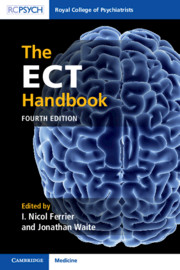Book contents
- The ECT Handbook
- The ECT Handbook
- Copyright page
- Contents
- Contributors
- Preface
- Chapter 1 The Place of ECT and Related Treatments in Contemporary UK Psychiatry
- Chapter 2 Mechanism of Action of ECT
- Chapter 3 ECT in the Treatment of Depression
- Chapter 4 ECT in Mania (and Mixed States)
- Chapter 5 Electroconvulsive Therapy in Bipolar Disorder Depression
- Chapter 6 ECT in Older Adults
- Chapter 7 ECT in People with an Intellectual Disability
- Chapter 8 ECT in Pregnancy and Postnatally
- Chapter 9 Electroconvulsive Therapy in Children and Adolescents
- Chapter 10 The Use of ECT in the Treatment of Schizophrenia
- Chapter 11 The Use of ECT in the Treatment of Catatonia
- Chapter 12 ECT in Neuropsychiatric Disorders
- Chapter 13 Cognitive Side-Effects of ECT
- Chapter 14 Non-cognitive Adverse Effects of ECT
- Chapter 15 Transcranial Magnetic Stimulation
- Chapter 16 Neurosurgery for Mental Disorder
- Chapter 17 Ketamine for Psychiatric Disorders
- Chapter 18 The ECT Accreditation Service (ECTAS)
- Chapter 19 The Scottish ECT Accreditation Network (SEAN)
- Chapter 20 Medical Training for Psychiatrists in ECT
- Chapter 21 Nursing Care of the Patient Receiving ECT and the Roles of the ECT Nurse
- Chapter 22 Practical Aspects of ECT
- Chapter 23 Anaesthesia for Electroconvulsive Therapy
- Chapter 24 Dental Issues Related to ECT
- Chapter 25 Interactions between ECT and Prescribed Medication
- Chapter 26 Seizure Monitoring in ECT
- Chapter 27 Safe ECT Practice in People with a Physical Illness
- Chapter 28 Capacity, Consent and the Law
- Chapter 29 Patients’, Carers’ and the Public’s Perspectives on ECT and Related Treatments
- Index
- References
Chapter 27 - Safe ECT Practice in People with a Physical Illness
Published online by Cambridge University Press: 27 June 2019
- The ECT Handbook
- The ECT Handbook
- Copyright page
- Contents
- Contributors
- Preface
- Chapter 1 The Place of ECT and Related Treatments in Contemporary UK Psychiatry
- Chapter 2 Mechanism of Action of ECT
- Chapter 3 ECT in the Treatment of Depression
- Chapter 4 ECT in Mania (and Mixed States)
- Chapter 5 Electroconvulsive Therapy in Bipolar Disorder Depression
- Chapter 6 ECT in Older Adults
- Chapter 7 ECT in People with an Intellectual Disability
- Chapter 8 ECT in Pregnancy and Postnatally
- Chapter 9 Electroconvulsive Therapy in Children and Adolescents
- Chapter 10 The Use of ECT in the Treatment of Schizophrenia
- Chapter 11 The Use of ECT in the Treatment of Catatonia
- Chapter 12 ECT in Neuropsychiatric Disorders
- Chapter 13 Cognitive Side-Effects of ECT
- Chapter 14 Non-cognitive Adverse Effects of ECT
- Chapter 15 Transcranial Magnetic Stimulation
- Chapter 16 Neurosurgery for Mental Disorder
- Chapter 17 Ketamine for Psychiatric Disorders
- Chapter 18 The ECT Accreditation Service (ECTAS)
- Chapter 19 The Scottish ECT Accreditation Network (SEAN)
- Chapter 20 Medical Training for Psychiatrists in ECT
- Chapter 21 Nursing Care of the Patient Receiving ECT and the Roles of the ECT Nurse
- Chapter 22 Practical Aspects of ECT
- Chapter 23 Anaesthesia for Electroconvulsive Therapy
- Chapter 24 Dental Issues Related to ECT
- Chapter 25 Interactions between ECT and Prescribed Medication
- Chapter 26 Seizure Monitoring in ECT
- Chapter 27 Safe ECT Practice in People with a Physical Illness
- Chapter 28 Capacity, Consent and the Law
- Chapter 29 Patients’, Carers’ and the Public’s Perspectives on ECT and Related Treatments
- Index
- References
Summary
People with a wide range of physical illnesses are successfully treated with ECT (Tess & Smetana, 2009). Some medical problems may cause particular concern, especially cardiovascular and neurological problems.
- Type
- Chapter
- Information
- The ECT Handbook , pp. 247 - 253Publisher: Cambridge University PressPrint publication year: 2019

